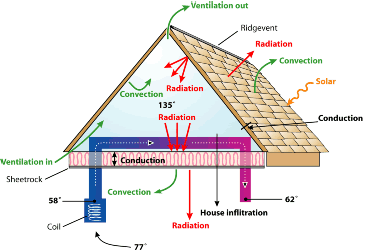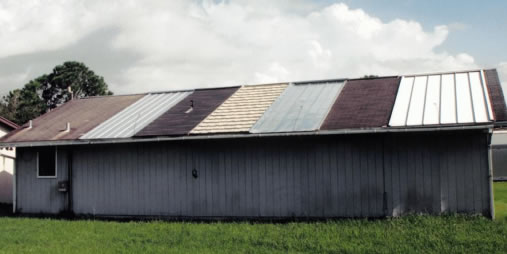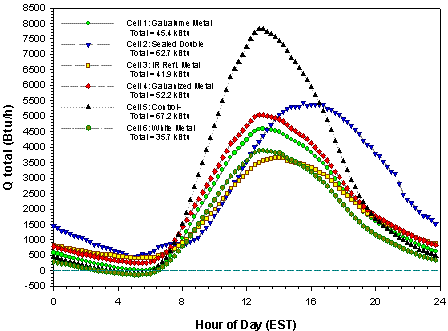| |
|
| |
| Reference
Publication:
Chandra, Subrato, Neil Moyer, Danny Parker, David Beal,
David Chasar, Eric Martin, Janet McIlvaine, Ross McCluney,
Andrew Gordon, Mike Lubliner, Mike McSorley, Ken Fonorow,
Mike Mullens, Mark McGinley, Stephanie Hutchinson, David
Hoak, and Linda Tozer. Building America Industrialized
Housing Partnership, Annual Report - Fourth Budget Period.
04/01/03-03/31/04. |
|
|
| Building
America Industrialized Housing Partnership, Annual
Report - Fourth Budget Period |
|
|
Subrato
Chandra, Neil
Moyer, Danny
Parker, David
Beal, David
Chasar, Eric
Martin, Janet
McIlvaine, Ross
McCluney, Andrew
Gordon, Mike
Lubliner, Mike McSorley, Ken
Fonorow, Mike
Mullens, Mark
McGinley, Stephanie
Hutchinson, David
Hoak, and Linda Tozer |
|
| Florida
Solar Energy Center |
|
| |
|
 |
Figure
68. Vented attic thermal processes. |
Flexible
Roofing Facility: Improving attic thermal performance
is fundamental to controlling residential cooling loads
in hot climates. Research shows that the influence of attics
on space cooling is not only due to the change in ceiling
heat flux, but often due to the conditions within the attic,
and their influence on duct system heat gain and building
air infiltration. (Please see Figure 68.)
The
importance of ceiling heat flux has long been recognized,
with insulation a proven means of controlling excessive
gains. However when ducts are present in the attic, the
magnitude of heat gain to the thermal distribution system
can be much greater than the ceiling heat flux. This influence
may be exacerbated by the location of the air handler within
the attic space - a common practice in much of the southern
US. Typically an air handler is poorly insulated and has
the greatest temperature difference at the evaporator of
any location in the cooling system. It also has the greatest
negative pressure just before the fan so that some leakage
into the unit is inevitable.
The
Flexible Roof Facility (FRF), located in Cocoa, Florida,
is designed to simultaneously evaluate five roofing systems
against a control roof with black shingles and vented attic.
Please see Figure 69.) The test evaluated how roofing systems
impact summer residential cooling energy use and peak demand.
In the summer of 2002, the following roofing systems were
tested (Please see Table 26.)
 |
|
Figure 69. Flexible Roof Facility in summer 2002
configuration. Cells are numbered
from left to right.
|
| Cell
# |
Roof
Material |
Ventilation
|
Roof
Cooling Load Reduction |
Overall
Cooling Savings |
| #1 |
Galvalume
unfinished 5-vee metal |
vented |
32% |
11% |
| #2 |
double
roof with radiant barrier (ins roof deck) |
sealed |
7% |
2% |
| #3 |
high
reflectance ivory metal shingle |
vented |
38% |
12% |
| #4 |
galvanized
unfinished 5-vee metal |
vented |
22% |
7% |
| #5 |
black
shingles (control cell) |
vented |
control |
control |
| #6 |
white
standing seam metal |
vented |
7% |
2% |
Table
26. 2002 roof cell configurations.
All
roof cells had R-19 insulation installed on the attic floor,
except the double roof configuration (Cell #2) which had
a level of R-19 open cell foam sprayed onto the bottom of
the roof decking. Measured thermal impacts included ceiling
heat flux, unintended attic air leakage, and duct heat gain.
The
sealed attic double roof system (Cell #2) provided the coolest
attic space of all systems tested (average maximum mid-attic
temperature was 81.1oF), and therefore had the
lowest estimated impact due to return air leakage and duct
conduction heat gains. However this cell also had the highest
ceiling heat flux of all strategies tested, and recorded
the most modest space cooling reduction (7%), relative to
the control roof.
Metal
roof testing was given more emphasis in 2002 due to the
popularity of these products. Researchers tested both galvanized
and Galvalume roofs. Galvalume is a cold-rolled
sheet with a highly corrosion-resistant hot-dip metallic
coating application of 55% aluminum 43.4% zinc, and 1.6%
silicon. These roofs are reported to better maintain solar
reflectance than galvanized roofing systems. Average daily
mid-attic maximum temperatures for the Galvalume
and galvanized metal roof systems were roughly similar (19.6oF
and 17.3oF cooler than the control roof, respectively).
The estimated total heat gain for these roof cells also
were relatively close.
The
highly reflective ivory metal shingle roof (Cell #3) provided
the coolest peak attic temperature of all the cells without
roof deck insulation. Its average maximum daily mid-attic
temperature was 93.3oF (23.4oF lower
than the control dark shingle cell). While the ivory metal
shingle roof's reflectance was slightly lower than the two
metal roofs and white metal roof, researchers noted that
the air space under the metal shingles provided additional
effective thermal insulation.
Researchers
also estimated the combined impact of ceiling heat flux,
duct heat gain, and unintended attic air leakage from the
various roof constructions. All of the alternative roofing
treatments produced lower estimated cooling energy loads
than the standard vented attic with dark shingles. (Please
see Figure 70.). The Galvalume roof clearly provided a
greater cooling energy use reduction than the galvanized
roof. This also was true during the 2001 study. Nighttime
attic temperatures and reverse ceiling heat flux have a
significant impact on the total daily heat gain, particularly
for metal roofs.
 |
| Figure
70. 2002 estimated combined impact of duct heat
gain, air leakage from the attic to conditioned space,
and ceiling het flux on space cooling needs on an average
summer day in a 2,000 ft2 home. |
|
Disclaimer:
This report was prepared as an account of work sponsored by an agency
of the United States government. Neither the United States government
nor any agency thereof, nor any of their employees, makes any
warranty, express or implied, or assumes any legal liability
or responsibility for the accuracy, completeness, or usefulness
of any information, apparatus, product, or process disclosed,
or represents that its use would not infringe privately owned
rights. Reference herein to any specific commercial product,
process, or service by trade name, trademark, manufacturer,
or otherwise does not necessarily constitute or imply its endorsement,
recommendation, or favoring by the United States government
or any agency thereof. The views and opinions of authors expressed
herein do not necessarily state or reflect those of the United
States government or any agency thereof.
|






